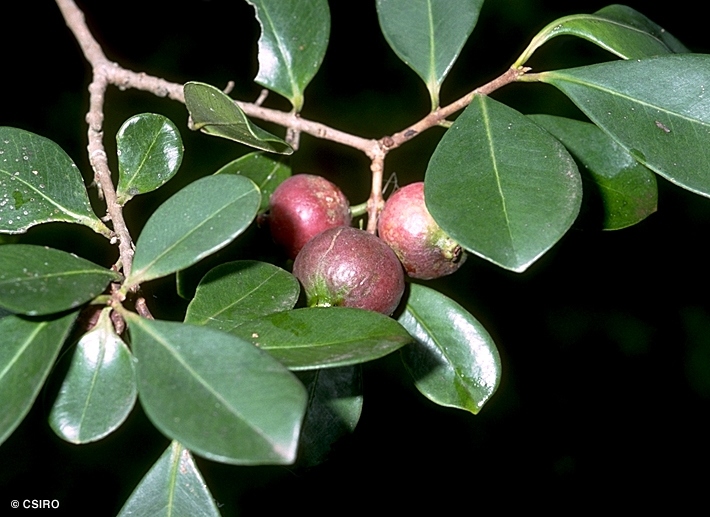Australian Tropical Rainforest Plants - Online edition
Psidium cattleyanum Sabine





Sabine, J. (1822) Transactions of the Horticultural Society of London 4 : 317. Type: Cultivated plant grown from seed received from China, W. Cattley.
Purple Guava; Cattley Guava; Cherry Guava; Guava; Guava, Cherry; Strawberry Guava; Guava, Cattley
Oil dots visible with a lens if not visible to the naked eye. Stipules small and inconspicuous, shed early. Leaf blades about 4.5-9 x 2.2-4.5 cm. Midrib flush with the upper surface. Lateral veins not raised on the underside of the leaf blade. The reticulate veins between the main lateral veins appear to flow from the midrib towards the leaf margin. Intramarginal vein not well developed.
Flowers strongly perfumed, the odour difficult to describe. Calyx tube (hypanthium) splits into about 4-6 lobes when the flower opens. Calyx tube (hypanthium) + lobes about 8 x 5 mm at the flower bud stage. Petals about 4-5 x 4-5 mm.
Cotyledons ovate, about 7-9 mm long, apex apiculate, base rounded to cuneate. Oil dots visible with a lens. At the tenth leaf stage: leaf blade obovate to elliptic, apex acute or shortly acuminate, base cuneate, upper surface glabrous, a few pale hairs present on the underside towards the base and around the margin; oil dots small and numerous; petiole hairy; stipules or stipule-like glands may be present. Seed germination time 30 days.
An introduced species, originally from Brazil, widely cultivated in Queensland and now naturalised in NEQ on parts of the Atherton and Windsor Tablelands, and possibly in CEQ. Altitudinal range not certain but collected at 400-750 m. Grows as an understory tree in disturbed rain forest.
Originally introduced for its edible fruits, it can now be found in several rain forest areas.





